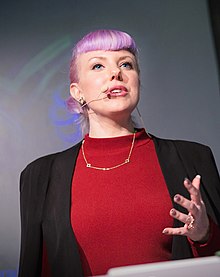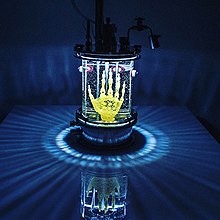Amy Karle
Amy Karle | |
|---|---|
 Amy Karle in 2019 | |
| Born | 1980 (age 43–44) New York, U.S. |
| Notable work | Regenerative Reliquary, Internal Collection, Heart of Evolution?, Biofeedback, Cyborg Couture |
| Movement | Ultra-contemporary art, contemporary art, conceptual art, new media art, bioart, hybrid arts, digital art, computational art, performance art |
| Website | www |
Amy Karle (born 1980) is an American artist, bioartist, and futurist whose work focuses on the relationship between technology and humanity, specifically how technology and biotechnology impact health, humanity, society, evolution, and the future.[1][2][3] Karle combines science and technology with art and is known for using living tissue in her work.[4][5][6]
In 2018, Karle was an Artist Diplomat[7][8] sponsored by the U.S. Department of State, for a cultural exchange initiative in conjunction with the Copernicus Science Center in Poland where she led workshops focusing on women's empowerment in STEAM fields.[9][10] In 2019, she was named one of the BBC's 100 women.[11]
Personal life
Karle was born in New York in 1980[12] and grew up in Endicott, outside the upstate city of Binghamton. Her mother was a biochemist and her father was a pharmacist and Karle has said she "grew up in the lab and in the pharmacy".[13] Karle is an alumnus of the School of Art and Design at Alfred University and Cornell University where she received degrees in Art and Design and Philosophy.[14]
Karle was born with a rare condition, aplasia cutis congenita, missing a large region of skin on her scalp and also missing bone in her skull. She underwent a series of experimental surgical procedures as a child. The skin was repaired by tissue expansion surgery that was considered dangerous and experimental at the time that it was performed.[15][13] This experience impacted her work and desire to heal and enhance the human body and human condition.[16] This early experience also inspired her interest in the links between biology, medical futuring and art.[11][5]
Work
Karle researches and explores the impact of technology on bodily enhancement through her artwork.[6][17][2] Her work is often classified as bioart; she describes her intentions for this work:
My relationship with health and the future perspective of medicine reflects the story of my life, intertwined with medical challenges and the discovery of vulnerability, fragility, strength, and complexity of the human body. The narrative of illness, with all its fears, hopes, and the quest for healing, constitutes a common thread in my research and work."[18]
Karle has created a number of artworks and performances using biofeedback and neurofeedback including:[19] A work from 2011, Biofeedback Art, was a durational performance where Karle's body was connected to a Sandin Image Processor that detected the changes that occur while she meditated over periods of 5–8 hours. Video art was created in the form of projections during the process.[17] In the same year, Resonation involved an EEG neuroheadset connected to a Chladni plate to generate bio-signals into visuals and sounds. Her 2018 Performance in Salt Mine was conducted in the Bochnia Salt Mine and Wieliczka Salt Mine using an EEG neuroheadset to translate her brainwaves into digital music and projected visualizations, which were later used in a planetarium film she made.[20][21][19]
Karle was named as one of the BBC's 100 women in 2019.[11]
Selected works


Regenerative Reliquary (2016) is a sculpture that features a 3D-printed bioprinted hydrogel scaffold shaped like the bones of a human hand placed inside a glass vessel. Human Mesenchymal stem cells from a living donor were placed on the scaffold which over time grew into bone.[6][22][23][24] It has been exhibited internationally.[4][25][26]
Internal Collection (2016–2017) is a series of garments based on human anatomy. The fabrication consists of 3D body scanning, computer-aided design, laser cutting, and hand-sewing techniques to create representations of internal body systems.[27][28]
The Body and Technology: A Conversational Metamorphosis (2017) is a collection of 2D artworks by Amy Karle made by hand and with artificial neural networking, machine learning, and artificial intelligence. In this body of work, Karle coupled artificial intelligence in healthcare with generative design to devise a system for leveraging AI in the diagnosis of disease, with generative CAD designing replacement parts, and 3D bioprinting to create implants.[29]
Morphologies of Resurrection (2020) is a series of 6 sculptures created as part of a Smithsonian residency, and exhibited at the Smithsonian Institution.[30] Karle's process examined the possibilities of reconstructive technologies and future evolution through biotechnological advancements.[31][32] The artworks are novel evolutionary forms based upon extinct species to explore “hypothetical evolutions through technological regeneration”, 3D printed in biocompatible material.[33]
Artificial intelligence
Her AI and bio-AI hybrid artworks have been in museum exhibitions including: Artificial Intelligence: AI / The Other I Ars Electronica Linz, Austria,[4] La Fabrique Du Vivant Centre Pompidou, Paris, France,[26] and Future and the Arts: How Humanity Will Live Tomorrow Mori Art Museum, Tokyo, Japan.[12][34]
References
- ^ "'How I create art with human cells'". BBC News.
- ^ a b Schnugg, Claudia (28 February 2019). Creating ArtScience Collaboration: Bringing Value to Organizations. Springer. ISBN 9783030045494.
- ^ U.S. Department of State. "American Arts Incubator Exchange Artist Amy Karle". American Arts Incubator, initiative of the U.S. Department of State's Bureau of Educational and Cultural Affairs developed in partnership with ZERO1.
- ^ a b c Stocker, Gerfried; Schöpf, Christine; Leopoldseder, Hannes, eds. (2017). "AI Artificial Intelligence - Das andere Ich" (PDF). Ars Electronica. p. 44.
- ^ a b "The woman creating art with human stem cells". BBC News. 7 March 2020. Retrieved 6 March 2021.
- ^ a b c Elwell, Sage (7 December 2020). Religion and the Digital Arts. Brill Publishers. ISBN 978-90-04-44759-2.
- ^ "Atlas of Databodies". transcript publishing. Retrieved 14 May 2024.
- ^ "Imagining Life: Amy Karle's Artistic Research Practice" (PDF). Transcript.open. Retrieved 14 May 2024.
- ^ "American Artist and Copernicus Science Center Launch First Arts Incubator Program in Poland". Pl.usembassy.gov. 2 May 2018.
- ^ "Spis treści. Na okładce: Eksponat Chmury, dotyczący zmian klimatu, wystawa RE: Generacja. - PDF Free Download". Docplayer.pl.
- ^ a b c "BBC 100 Women 2019: Who is on the list this year?". BBC News. 16 October 2019. Retrieved 6 March 2021.
- ^ a b "Future and the Arts exhibition: How humanity will live tomorrow" (PDF). Mori Art Museum. Mori Arts Centre. March 2020. Retrieved 2 April 2021.
- ^ a b Mendoza, Hannah Rose (27 November 2017). "3D Printing Spotlight On: Amy Karle, Award Winning BioArtist". 3DPrint.com | The Voice of 3D Printing / Additive Manufacturing. Retrieved 6 March 2021.
- ^ "Amy Karle | American Arts Incubator". Retrieved 15 February 2022.
- ^ "Regenerating the human body with art: Amy Karle's bio-artistic proposal". Fahrenheit Magazine. 5 February 2021. Retrieved 6 March 2021.
- ^ "'How I create art with human cells'". BBC News.
- ^ a b Bart, Marlene; Breuer, Johannes; Freier, Alex Leo (2022). Atlas of Data Bodies 1: Body images in art, design and science in the age of digital media.Imagining Life: Amy Karle's Artistic Research Practice. Transcript. pp. 22–33. ISBN 978-3-8376-6178-1.
- ^ Villa, Erica (10 November 2023). "Where Will Biotechnology Take Us?". Radar Magazine. Retrieved 4 December 2023.
- ^ a b Twardoch-Raś, Ewelina (10 December 2019). "Pętle neurofeedbacku : elektroencefalografia jako strategia artystyczna w wybranych projektach z zakresu art & science". Kultura Współczesna. 4 (107). doi:10.26112/kw.2019.107.11. Retrieved 10 December 2021.
- ^ Karle, Amy. "What is Life in the Bio-Tech Era? Creating a More Resilient Future". Americanartsincubator.org. Retrieved 10 December 2021.
- ^ "Arts Incubator Program Successfully Concludes with Exhibition at Copernicus Science Center". Pl.usembassy.gov. 21 May 2018. Retrieved 10 December 2021.
- ^ Callaghan, Meaghan Lee (12 October 2016). "An Artist Is Growing A Skeleton Human Hand In A Lab". Popular Science. Retrieved 12 August 2023.
- ^ Pangburn, D. J. (6 July 2016). "This Artist Is Biohacking The Body To 3D-Print Fantastical Human Bones". Fast Company. Retrieved 31 March 2021.
- ^ "Awareness in physical and mental changes in the bioart of Roy Ascott". Fahrenheit Magazine. 17 February 2021. Retrieved 21 June 2023.
- ^ Sina Contemporary Art (8 September 2018). "新浪当代艺术丨【干货】第二届北京媒体艺术双年展(BMAB)论坛 [The 2nd Beijing Media Art Biennale (BMAB) Forum]". Weixin Official Accounts Platform (Contemporary Art Channel). Retrieved 31 March 2021.
- ^ a b "Design: Expo "La Fabrique du vivant", le biodesign au Centre Pompidou". Paris-art.com. 17 March 2019.
- ^ "FILE FESTIVAL". file.org.br. Retrieved 21 June 2023.
- ^ Twardoch-Raś, Ewelina (2 November 2021). Sztuka biometryczna w perspektywie filozofii post- i transhumanizmu: w stronę estetyki postafektywnej (in Polish). Wydawnictwo UJ. ISBN 978-83-233-7212-7.
- ^ MacDonald, Amanda (17 February 2021). "Amy Karle BioArtist Invites Exponential Technologist To Collaborate". Ideaxme. (Podcast). Retrieved 2 December 2023.
- ^ "Smithsonian Releases 2.8 Million Images Into Public Domain". Smithsonian Magazine. Retrieved 10 December 2021.
- ^ "Open Access Remix". Smithsonian Institution. Retrieved 10 December 2021.
- ^ "21st-Century Diffusion with Smithsonian Open Access". Smithsonian Institution. Retrieved 10 December 2021.
- ^ "Futurist Amy Karle Unlocks the Potential of Humanity's Future". Design-milk.com. 6 April 2020. Retrieved 10 December 2021.
- ^ Joffrin, Laurent (28 November 2018). "A new special issue: AI, at the heart of the human". LIBERATION. Retrieved 22 June 2023 – via amykarle.com.
